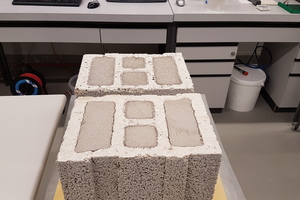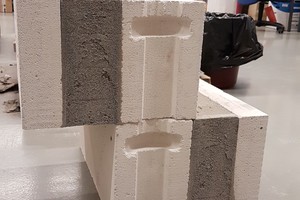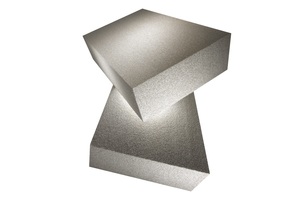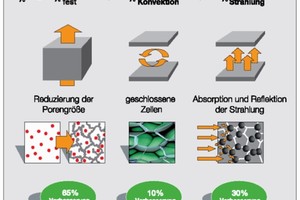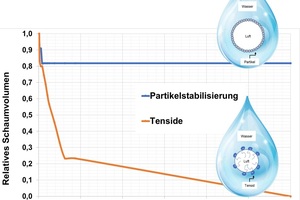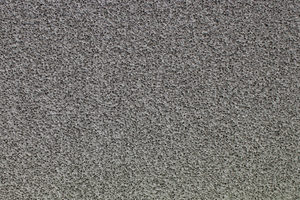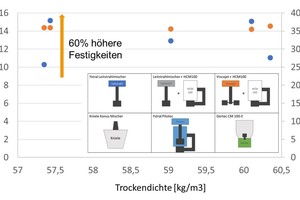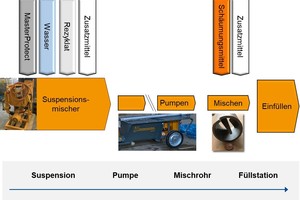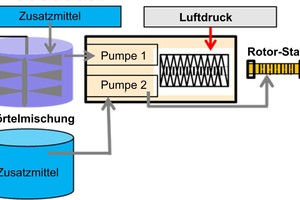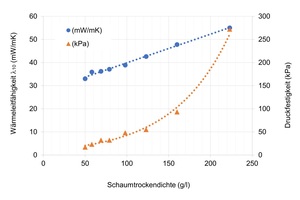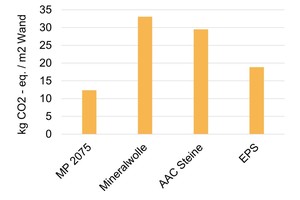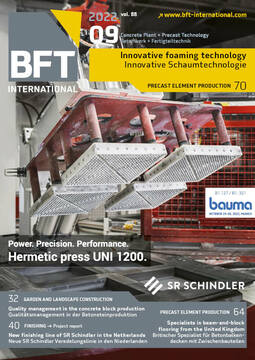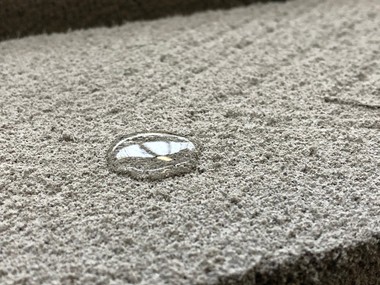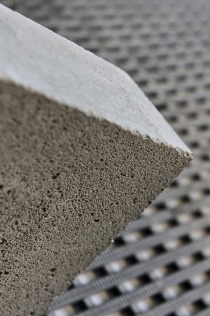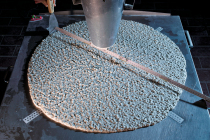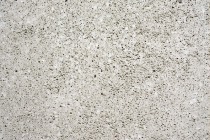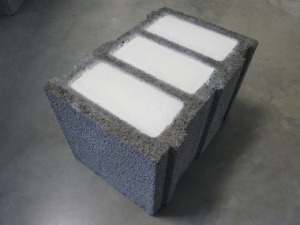Innovative foaming technology for sustainable and cost-efficient construction
MasterProtect NFF 2000 IN is a foaming technology for sustainable and cost-efficient construction. This article outlines the key characteristics of this new construction material, which has been patented by Master Builders Solutions Deutschland GmbH (MBSD) and De Cavis AG and is currently being launched.
1. Introduction and applications
Saving energy and avoiding carbon emissions are the challenges of our time. Cement-based construction materials account for 7% of global carbon emissions and thus contribute significantly to climate change. However, since the overall availability of alternative materials is very limited and even these do not necessarily contribute to climate-neutral construction, other routes towards more sustainable construction must also be taken, such as the increased use of recycled materials and the production of single-material components and lightweight materials that can be used in an optimized and efficient manner. Building with lightweight concretes is not new. Khan (2022) provides an overview of the different types of lightweight concrete used to date. However, lightweight concretes with dry densities as low as 50 g/l can be produced today, which represents a new class of lightweight cement-based materials referred to as cementitious insulating materials. Using such materials with densities below 100 g/l makes a major contribution to more sustainable construction. They meet the need for noncombustible, recyclable insulation materials that can be produced in a highly automated process. This article outlines the key characteristics of a new construction material patented by Master Builders Solutions Deutschland GmbH (MBSD) and De Cavis AG (patent number WO 2018/162381, 2018), which has been launched this year and is referred to as non-flammable foam (NFF) internally.
2. Insulation effect and challenges posed by inorganic foams
An insulating material’s effectiveness can be calculated in a simplified approach using the following parameters: the thermal conductivity of the matrix material, the proportion and size of the pores, and the capacity to absorb infrared radiation:
λdry = λMatrix = VMatrix + λAir * VPores – λRadiation
λMatrix = 300-600 mW/mK, depending on the suspension’s water content, the recipe, and the foaming and drying method; VMatrix = volume proportion of the matrix (2-5%); λAir = 27 mW/mK; VPores = volume proportion of air (95-98%); λRadiation = 1-1.5 mW/mK
Accordingly, the lowest calculated achievable thermal conductivity for dried NFF amounts to about 33.5 mW/mK. This value is reliably achieved with the formulation developed by MBSD and the associated process. Fig. 4 shows the related effects in a simplified manner: The smaller the pores and the lower the conductivity of the matrix material, the better the insulating effect will be.
A major disadvantage of inorganic matrix materials is their relatively slow reactivity, at least compared to organic polymers. However, the hardening process of the binder is necessary to stabilize the air bubbles in the long term. To achieve very low densities, it is thus necessary to stabilize the air by means of a surfactant until the binder has developed sufficient viscosity or strength and can fulfil this function itself.
3. Air stabilization and foaming technology
Air is usually introduced into mortar by means of highly porous lightweight fillers or surfactants. However, recent research highlights the potential of alternative approaches: Xanthan gum can also stabilize air, and the use of partially activated micro-particles can also significantly improve air stability (Gonzenbach , Studart, Tervoort, & Gauckler, 2006).
3.1 Air stabilization by means of surfactants and
particles
MBSD has favored the use of micro-particles for stabilizing the air voids in the MasterProtect NFF 2000 IN product. These particles allow for the production of a very stable foam at very low dry density levels. They form an almost complete closed-cell shell structure during foaming in the air/water transition zone. The volume of the foam thus remains stable over 24 hours and allows for reproducible foaming even at low and very high temperatures, irrespective of the binder reaction. Compared to open-cell foam systems, strength increases by about 20%, while water absorption is significantly reduced. Fig. 5 shows the volume stability of template foams produced with the aid of surfactants and particles.
The final foam structure results from the interaction of various admixtures, such as hydrophobing agents and dispersions, as well as air stabilization. To achieve optimum results, the organic admixture chemistry must be set accordingly. Only then can homogeneous, fine and uniform pore structures be achieved reliably. Fig. 6 shows how the interaction between organic chemistry and particle stabilization leads to different results in the pore structure.
3.2 Mixing technologies
Reliably achieving target densities also requires optimized mixing technology. Mixers for the production of cementitious insulating materials must meet the following requirements:
1. Air introduction during the mixing process should be minimal and always remain at a constant level.
2. A large amount of mixing energy should be introduced into the system within a very short time.
3. Fibers and hydrophobic aggregates must not segregate.
Provided the mixer meets these criteria, strength increases by up to 60% can be expected when using colloidal mixers, for example, simply through optimizing the mixing setup. Fig. 7 shows the comparison of different mixer types with identical starting formulations, water contents and mixing times. Variations in the results are mainly due to the mixing equipment used.
3.3 Mechanical vs. chemical foaming
MasterProtect NFF can be foamed in a chemical (Fig. 8) or mechanical process (Fig. 9) in densities ranging from 50 to 700 g/l. The specific application defines which process is more appropriate. Generally speaking, a distinction can be made between highly industrialized processes (Figs. 1 and 3), which are designed for high productivity and thus predominantly rely on chemical foaming, and semi-manual processes, which tend to use mechanical foaming. The latter can achieve output rates in excess of 14 m3/h, while chemical foaming reaches more than 200 m3/h.
4. Formulation
Luansu Wei described new cementitious lightweight mortars based on hollow microspheres, OPC and fillers in 2021. MBSD had also been following this approach at the initial stages. However, it was found that the use of hollow microspheres failed to improve the material characteristics significantly. Today, the formulations are based on a rapid cement and special fillers and additives (Fig. 10).
The water/solids content can be varied across a wide range and has a considerable influence on the solid foam characteristics.
5. Solid foam characteristics
5.1 Measurement methods
Determining the compressive strength of highly porous and brittle materials is difficult and requires a great deal of experience. New measurement methods such as determining the compressive strength under triaxial stress can provide information on failure mechanisms. The measured values shown here were determined according to DIN EN 826 after 7 days. The thermal conductivity was measured according to DIN EN 12667. The specimens were dried at 40 °C and measured in an EP 500 l system until a constant heat flux was reached.
5.2 Measurement results
The density of the foam system varies greatly depending on the point in time considered. A distinction is made between the bulk density of the dry compound (approx. 650 g/l), wet mix (1,100 g/l), wet foam density (150 g/l), and dry foam density (75 g/l). These differences must be taken into account in volume and recipe calculations. Fig. 11 shows the interdependencies of density, thermal conductivity and strength. When dried at 70 °C at a density of 50 g/l, MasterProtect NFF 2000 IN reaches a thermal conductivity of 31.5 mW/mK, which has not been achieved so far for cementitious insulating materials. However, this value is only of limited practical relevance because additional moisture- and aging-related safety margins have to be taken into account for the design value. The design value envisaged for the approval thus amounts to approx. 35 mW/mK.
5.3 Sustainability and circularity
The Institut für Bauen und Umwelt certified an insulating panel with a density of 70 g/l and prepared an Environmental Product Declaration (EPD) for it. This EPD is based on the U-value of the insulation material, making it possible to calculate the U-value and compare the sufficiency with other insulating materials. Fig. 12 shows the result of such an analysis for a target U-value of 150 mW/m2K. This approach can be used to show how sustainable a cementitious insulation material can be in a system comparison.
During the product development phase, great importance was also attached to the possible use of recycled constituents from the very beginning. The product is designed in such a way that the use of 10% by mass of recycled material is possible without compromising its performance characteristics. However, the grading curve of the recycled material must be selected such that it matches the curve of the filler it replaces.
6. Conclusion
With its new MasterProtect NFF 2000 IN product, MBSD is making a significant contribution to more sustainable construction with cementitious binders. This product sets a new benchmark in sustainability while being noncombustible (A1) and fully recyclable. In addition, the concrete industry can implement automated production processes for installing insulation layers.
CONTACT
Master Builders Solutions Deutschland GmbH
Glücksteinallee 43-45
68163 Mannheim/Germany
+49 1525-6449637
stephan.siegle@mbcc-group.com
www.master-builders-solutions.com
De Cavis AG
Im Schossacher 21
8600 Dübendorf/Switzerland
info@decavis.com
www.decavis.com

